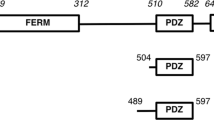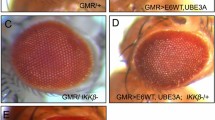Abstract
Human papillomavirus type 16 E5 protein (HPV16 E5) upregulates ligand-mediated activation of the epidermal growth factor receptor (EGFR) in transfected human keratinocytes. HPV16 E5 binds to the 16 kDa proteolipid (subunit c) of the vacuolar H+-ATPase (16K), responsible for endosomal acidification, and this binding has been suggested to be responsible for increased recycling of the EGFRs. Using mutant deletions we show here that amino acids 54–78, but not 79–83 are necessary for binding to the 16K proteolipid. EGF treatment of cells expressing wild type or mutants of the E5 protein show that deletion of the last carboxy terminal 5 amino acids results in loss of E5-mediated EGFR overactivation. Thus, our results show that the binding capacity of HPV16 E5 to 16K can be dissociated from the effect of the viral protein on EGFR activation.
This is a preview of subscription content, access via your institution
Access options
Subscribe to this journal
Receive 50 print issues and online access
$259.00 per year
only $5.18 per issue
Buy this article
- Purchase on Springer Link
- Instant access to full article PDF
Prices may be subject to local taxes which are calculated during checkout





Similar content being viewed by others
References
Andresson T, Sparkowski J, Goldstein DJ and Schlegel R. . 1995 J. Biol. Chem. 270: 6830–6837.
Ashrafi GH, Pitts JD, Faccini AM, McLean P, O’Brien V, Finbow ME and Campo MS. . 2000 J. Gen. Virol. 81: 689–694.
Bauer-Hofmann R, Borghouts C, Auvinen E, Bourda E, Rösl F and Alonso A. . 1996 Virology 217: 33–41.
Bouvard V, Matlashewski G, Gu ZM, Storey A and Banks L. . 1994 Virology 203: 73–80.
Bubb V, McCance DJ and Schlegel R. . 1988 Virology 163: 243–246.
Burkhardt A, Willingham M, Gay C, Jeang KT and Schlegel R. . 1989 Virology 170: 334–339.
Conrad M, Bubb VJ and Schlegel R. . 1993 J. Virol. 67: 6170–6178.
Crusius K, Auvinen E, Steuer B, Gaissert H and Alonso A. . 1998 Exp. Cell Res. 241: 76–83.
Dunlop J, Jones PC and Finbow ME. . 1995 EMBO J. 14: 3609–3616.
Dürst M, Dzarlieva-Petrusevska RT, Boukamp P, Fusenig NE and Gissmann L. . 1987 Oncogene 1: 251–256.
Faccini AM, Cairney M, Ashrafi GH, Finbow ME, Campos MS and Pitts JD. . 1996 J. Virol. 70: 9041–9045.
Faulkner-Valle G and Banks L. . 1995 J. Gen. Virol. 76: 1239–1245.
Finbow ME and Harrison MA. . 1997 Biochem. J. 324: 697–712.
Finbow ME, Pitts JD, Goldstein DJ, Schlegel R and Findlay JBC. . 1991 Mol. Carcinogen. 4: 441–444.
Goldstein DJ and Schlegel R. . 1990 EMBO J. 9: 137–145.
Goldstein DJ, Andresson T, Sparkowski JJ and Schlegel R. . 1992a EMBO J. 11: 4851–4859.
Goldstein DJ, Finbow ME, Andresson T, McLean P, Smith K, Bubb V and Schlegel R. . 1991 Nature 352: 347–349.
Goldstein DJ, Kulke R, DiMaio D and Schlegel R. . 1992b J. Virol. 66: 405–413.
Hasebe M, Hanada H, Moriyama Y, Maeda M and Futai M. . 1992 Biochem. Biophys. Res. Commun. 183: 856–863.
Hwang ES, Nottoli T and DiMaio D. . 1995 Virology 211: 227–233.
Kell B, Jewers RJ, Cason J, Pakarian F, Kaye JN and Best JM. . 1994 J. Gen. Virol. 75: 2451–2456.
Leechanachai P, Banks L, Moreau F and Matlashewski G. . 1992 Oncogene 7: 19–25.
Leptak C, Ramón y Cajal S, Kulke R, Horwitz BH, Riese II DJ, Dotto GP and DiMaio D. . 1991 J. Virol. 65: 7078–7083.
Martin P, Vass WC, Schiller JT, Lowy DR and Velu TJ. . 1989 Cell 59: 21–32.
Matlashewski G, Schneider J, Banks L, Jones N, Murray A and Crawford L. . 1987 EMBO J. 6: 1741–1746.
Neal MA and McCance DJ. . 1995 J. Invest. Dermatol. 105: 668–700.
Oelze I, Kartenbeck J, Crusius K and Alonso A. . 1995 J. Virol. 69: 4489–4494.
Petti L and DiMaio D. . 1992 Proc. Natl. Acad. Sci. USA 89: 6736–6740.
Petti L, Nilson LA and DiMaio D. . 1991 EMBO J. 10: 845–855.
Pim D, Collins M and Banks L. . 1992 Oncogene 7: 27–32.
Pirisi L, Yasumoto S, Feller M, Doniger J and DiPaolo JA. . 1987 J. Virol. 57: 572–577.
Schapiro F, Sparkowski J, Adduci A, Suprynowicz F, Schlegel R and Grinstein S. . 2000 J. Cell Biol. 148: 305–315.
Skinner MA and Wildeman AG. . 1999 J. Biol. Chem. 274: 23119–23127.
Stoler MH, Rhodes CR, Whitbeck A, Wolinske SM, Chow LT and Broker TR. . 1992 Hum. Pathol. 23: 117–128.
Straight SW, Herman B and McCance DJ. . 1995 J. Virol. 69: 3185–3192.
Straight SW, Hinkle PM, Jewers RJ and McCance DJ. . 1983 J. Virol. 67: 4521–4532.
zur Hausen H and Schneider A. . 1987 In: The Papovaviridae. Salzman NP and Howley P. (eds). Plenum Press: New York. pp. 245–263.
zur Hausen H. . 1991 Virology 184: 9–13.
Acknowledgements
We would like to thank Pauline McLean and Jürgen Fisher for technical assistance and Dr Chris Bartholomew for reading the manuscript. This work was supported in part by the Cancer Research Campaign.
Author information
Authors and Affiliations
Rights and permissions
About this article
Cite this article
Rodríguez, M., Finbow, M. & Alonso, A. Binding of human papillomavirus 16 E5 to the 16 kDa subunit c (proteolipid) of the vacuolar H+-ATPase can be dissociated from the E5-mediated epidermal growth factor receptor overactivation. Oncogene 19, 3727–3732 (2000). https://doi.org/10.1038/sj.onc.1203718
Received:
Revised:
Accepted:
Published:
Issue Date:
DOI: https://doi.org/10.1038/sj.onc.1203718
Keywords
This article is cited by
-
Oncogenes and RNA splicing of human tumor viruses
Emerging Microbes & Infections (2014)
-
Human papillomavirus-16 E5 protein: oncogenic role and therapeutic value
Cellular Oncology (2012)
-
Papillomavirus E5: the smallest oncoprotein with many functions
Molecular Cancer (2011)
-
HPV16 E5 affects the KGFR/FGFR2b-mediated epithelial growth through alteration of the receptor expression, signaling and endocytic traffic
Oncogene (2011)
-
Expression of human papilloma virus type 16 E5 protein in amelanotic melanoma cells regulates endo-cellular pH and restores tyrosinase activity
Journal of Experimental & Clinical Cancer Research (2009)



